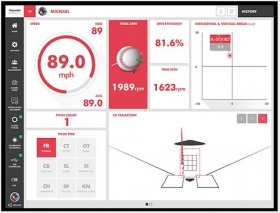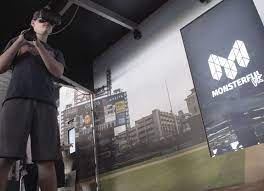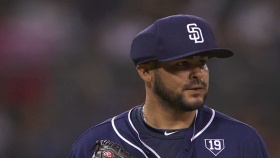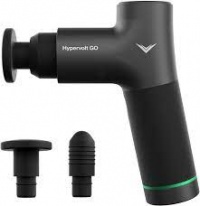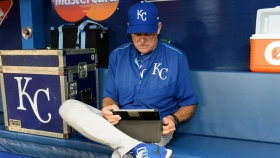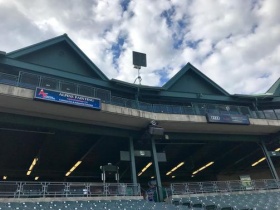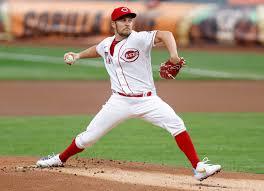Technology in Baseball
Baseball has been dominated by analytics for years and new technological developments have proven to have an immense impact on the nature of the game. New statistical tools and algorithms have changed how players are evaluated and allowed players to completely revamp their careers along with changing the way the game is played. From analytical-based decision-making to an increasing technological presence, the innovative changes to the game of baseball have had both short and long-term influences.
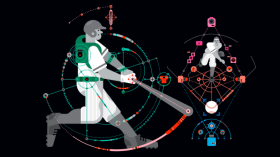
Contents
History
The baseball analytical movement was initiated by Bill James in 1982 with the publication of his book, ‘’The Bill James Baseball Abstracts.’’[2] James's analysis offered a different perspective on understanding the outcomes of each baseball “event” and pioneered baseball's fascination with numbers. James realized there was value in the static nature of baseball; the idea that each pitch and subsequent play is separate and can be recorded. He was the first to take advantage of the enormous quantity of information a single game of baseball produced. This initial movement materialized in the form of multiple new stats, like runs created and win shares, which were used as a baseline in evaluating new and existing players. [2]
In the early 2000s, Billy Beane introduced the next catalyst in this analytical movement while working as the general manager for Oakland A’s.[3] By valuing stats like on-base percentage over batting average, Beane built off of the work of James by prioritizing numbers and recorded results over the traditional eye test of mechanics and body types. Beane’s success, accompanied by the documentation of his story by Michael Lewis, influenced many other teams to start hiring more analytical minds, generating a new way of interest in the statistical analysis of baseball games.
Technology
General comfort and applicability with stats and analytics likely played a role in the relatively quick adoption of technology to improve performance. Around 2012, new machines capable of measuring a number of different variables on a moving baseball started to emerge throughout the Major League Baseball scene and drastically influenced the game.
Rapsodo
Rapsodo is a leading company in sport analytics technologies. They specialize in machines used for tracking movements of baseballs, softballs, and golf balls. For baseball, they have two separate machines with exceptionally high-quality cameras able to track things like spin rate and launch angle. The machines are each specialized for tracking pitches or batted balls but in general, these machines are used more often by pitchers than hitters. [4]
HitTrax
HitTrax is also a popular company in baseball for producing supplemental data on player performance. It condenses many of the capabilities of the Rapsodo machine into one device with an emphasized focus on collecting hitting metrics. It can calculate metrics such as the impact power and break of a pitch, but also offers simulation technology that allows players to simulate results in smaller spaces like batting cages. [5]
VR Training
Baseball athletes are now also using VR headsets to improve their baseball skillset. The VR headsets simulate the player standing at home plate as the batter. The players are sent pitches that they must decide whether or not to "swing" their bat at. Claims are that this sort of training helps players' plate discipline, as in the ability to stay patient and not swing at bad pitches.
According to VR companies like WIN Reality there are scientific benefits to the training:
Usually, “occlusion” is used in a medical context, referring to the obstruction of blood or other fluid flow. More broadly, however, it simply means that something is obstructed. Specifically for our context, occlusion refers to the obstruction of information about the true nature of a pitch type; or, what we know as pitch tunneling. Win Reality’s Occlusion Training teaches hitters to overcome tunneling by identifying previously unnoticed but available pieces of information about the pitch. Instead of being forced to guess what the pitch is going to be, Win Reality athletes learn how to “rely on the earliest bits of useful information indicating possible pitch type, location, and timing, to build predictive models (in their heads) and improve how they process that early information.” [6]
Essentially, WIN Reality asserts that Occlusion Training improves a hitters ability to recognize a specific type of pitch. This is achieved by somehow emphasizing or pointing out small, but visually available, details about a pitch in regards to the type of break it will have.
Protective Gear
In response to five Major League Baseball pitchers being struck in the head by line drives in 2016, the MLB began to explore new head protection technology for its pitchers. The MLB prototyped a “hybrid of a cap and a helmet” that aimed to protect the areas of the head that are most susceptible to catastrophic injuries. The prototype was manufactured by baseball company isoBLOX and is meant to be worn under standard New Era nylon caps. [7] The product, despite being very effective, raised doubts among its users. Dan Jennings of the Miami Marlins was one pitcher who was stuck with a 101 mph liner to the head in 2014. Still, in an interview afterward, he expressed that “I don’t think many guys will wear anything unless it is mandatory.” [8]
Recovery
In the past year, the MLB has put an emphasis on recovery technology. In 2020 they announced a partnership with Hyperice to make them the official recovery technology of the MLB. Hyperice focuses on percussion technology, vibration technology, dynamic air compression technology, and thermal technology. Baseball is very tough on players' joints and muscles, and many players used Hyperice technology after games and practices to recover. The largest part of this deal is that it now allows players to use Hyperice’s technology during games in the dugout, which will make recovery after games much easier and performance during the game better. [9]
The Tampa Bay Rays and Analytics
Using analytical methodologies to make important decisions in sports, especially baseball, has not been widely accepted by all as of yet. Some argue that analytics should not be applied to sports as important decisions should be made by humans who understand the context of the situation. However, some argue that using analytical based decisions give a team the best chance at winning a game.
One of the most analytically based teams in the MLB is the Tampa Bay Rays. The Rays are a small market team, meaning that they do not have the money or brand name to attract top talent to their team. [10] As a result they have to get creative to assemble a competitive team every year in order to have the best chance of winning the World Series. One of the ways they get creative is by relying heavily on analytics. [11]
Analytics have actually treated the Tampa Bay Rays very well in recent years as they have won a lot of baseball games and even made it to the World Series last year in 2020. However, one major analytical decision that was made in the World Series has a lot of people questioning the effectiveness of analytics in baseball. In game 6 of the World Series, Blake Snell was pitching a shutout for the Rays, letting up zero runs through 5 innings and tallying nine total strikeouts. This was an extremely impressive feat against a worthy opponent in the LA Dodgers. However, the analytical models that the Rays used told the manager to take Snell out of the game because he had already faced each of the Dodgers batters twice in the game. Analytics say that the third time a pitcher faces a batter, the batter has a significantly higher chance of success. [12] Even though Snell was playing phenomenal baseball, the Rays manager decided to take him out of the game. After this happened, the Rays reliever pitcher let up two quick runs, which lead the Dodgers to victory. On the biggest stage in baseball, it had appeared that the analytics failed and caused the Rays to lose the World Series. However, it is important to put this into context because the analytics allowed the small market team to be competitive the entire year and have a shot of winning a championship in the first place.
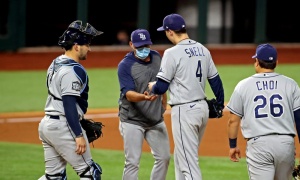
MLB/Apple iPad deal
In 2016 the MLB signed a multi-year agreement with Apple to provide every team with iPad Pro tablets in an effort to assist coaching staffs with making data-based decisions. [14] Teams are able to access all of their statistics during the game with an app on their iPad called MLB Dugout. The application is developed and maintained by MLB’s New York-based Advanced Media division alongside Apple. The data used by each team in the app is proprietary to each team, creating emphasis for baseball teams to develop their own data analytics team. This change drew similarities with the $400-million agreement between Microsoft Surface tablets and the NFL. The main difference between these agreements is that Apple will not require managers to use their iPad’s. Pirate’s manager Clint Hurdle expressed his interest in the devices but ultimately decided to not use one as he expressed faith in his coaches to relay prevalent information to him instead. [15]
Atlantic League
A very common occurrence when watching a baseball game is when players, coaches, and even fans are yelling at the umpire about his ball/strike calls. The Atlantic League is a minor league baseball league made up of 8 teams. Their decision to switch to an automated strike zone has been the source of much controversy, with some seeing it as innovative and some seeing it as risky. [16]
Blue Crabs player Kent Blackstone voiced his support saying he’s happy to be around it because he thinks that it could be the future of the MLB.[17] On the other side, Stan Cliburn the manager of the Blue Crabs blamed a loss on a calibration error after a thunderstorm. The technology prefers clear skies so when they lost a game on a questionable strike call with overcast skies, Cliburn was quick to criticize the technology. [17]
The technology, named TrackMan, works by using a 3D Doppler radar dish in a black box located in each Atlantic League ballpark. This creates a 3D strike zone unique to each player based on their size. The TrackMan records of the pitch is a ball or a strike after the pitch is thrown and then the result is transmitted to the umpire behind the base through an earpiece and then the umpire reads the call out. [18]
This technology, while obviously very innovative, has a long way to go until it can be accepted as a viable replacement for current methods of tracking pitches. In fact, the Atlantic League has had to create rules to account for the errors in the tech. One such rule states, “if the ABS (automated balls and strikes) system goes down for two or more batters in one half-inning, it has to be shut down for the other half of the inning as well in the interest of fairness.” [19]
Player Improvement
These technologies have proven to have huge benefits for player improvement. With so much data available, players have been able to tweak very specific things in their mechanics to drastically change results. Trevor Bauer is one of the most popular examples of a pitcher using this technology to improve their performance. He, along with many others, have started to use machines from Rapsodo to increase movement on their pitches or even invent new ones.[20] Additionally, hitters use this technology to perfect their swing mechanics. They strive for maximized exit velocity and will even change their swing path looking for a more advantageous launch angle. This technology has become integral to the professional baseball player's routine and influenced major changes in the way the game is played. The emphasis on launch angle has led to an increase in home runs, while the emphasis on pitch movement has certainly played some role in the increase in strikeouts. These trends cannot solely be attributed to the new technology available to players, but tech certainly played some part.[20]
Covid-19 and Technological Implications
The effects of Covid-19 in Baseball, just like every other sport, was significant. Due to the limitations imposed by governing bodies on in-person practices and training camps, majority of the MLB teams were forced to come up with alternative methods to ensure that their operations were not disrupted. Some of these operations, including the upcoming MLB Draft in which teams draft players straight out of college, were conducted through reliance on technology and sports analytics[21]. Due to the fact that the act of hitting and pitching in baseball have distinct locations, it is relatively easier to quantify these statistics and compare them among each other. In order to adapt to Covid-19 and help young players cope with this problem, Pocket Radar, a data-analytics company, opened up its database to public and allows every player with credentials to post their stats in order to get recognition.[22] In fact, Steve Goody, CEO of Pocket Radar, described this situation as “With the way MLB is doing data-driven analysis, you’re going to blink an eye and you’re going to have athletes at home who are going to be in possession of the digital resume- and they’re going to be back in control more.”[23]. While these digital platforms proved to be an effective solution in the short-term to mitigate the effects of Covid-19, the impacts of these models as well as their accuracy in the long-run is yet to be determined.
Ethical Implications
Unequal Access
The dominance of technology and analytics in baseball has leveled the playing field in many ways. The emphasis on numbers slightly reduces the level of bias executives might take based on a player's physical appearance. However, the technology is very expensive (a Rapsodo machine costs anywhere between $4,000 and $9,000) [4] which means it’s not very accessible. Thus, as with most technology, there exists a technological gap between communities that can use this technology and ones that can't. When it comes to Major League Baseball, this gap doesn't exist. But it is much more apparent at the lower levels of the sport. For example, bigger colleges in the more profitable conferences are able to afford this machine and use it to improve their player's performance whereas Division III schools that are considerably smaller in size aren't. The existence of this technology has not created this gap, but it has accentuated it; making it harder for players starting at smaller schools or in lower-income communities to improve at the same rate. [24]
Cheating
The increased use of technology in baseball has opened the doors to cheating within Baseball. Multiple scandals within the last five years involving the use of technology have called for regulation when it comes to the use of different devices. As is the case in many fields, as technology advances at such a high rate, regulations often have to be reactionary because the technology is so new. In 2017, the Astros used an aspect of their new technology to cheat. That season, their video replay room used live video feeds mid-game to decode signs used by the catcher to communicate to his pitcher. The decoded signs, not supposed to be of knowledge to the other team, were passed to a player who would relay the decoded information to the dugout. In 2018, the Astros, relocated their video replay room closer to their dugout. With this new closer location, the Astros created a “banging scheme,” which involved hitting trash cans to relay information. One bang represented an off-speed pitch, while two indicated a fastball, according to MLB documents. [25] The MLB changed rules about live camera feeds for the 2020 season as a reaction to the Astros World Series scandal of 2017, but it was met with some backlash from players who used the technology legally in the seasons before. [26]. Although MLB's stance on using technology to get a jump-start has been clear, MLB still hasn't come up with a legal framework to tackle and regulate future issues.
Regulation
On January 13th, Major League Baseball commissioner Rob Manfred assured fans that new protocols will be implemented to prevent cheating and monitor the use of technology in baseball. The move came after the most recent scandals involving technology to be used for sign-stealing. One of the protocols that is being discussed is banning the access of teams to video conference rooms after the game starts. According to Rob Manfred, MLB commission should “continue to evaluate where we have technology proximate to the dugout and whether there are technology changes that could be helpful in resolving this issue,". Manfred also said, "On the one hand you can attack the problem by saying, 'I'm going to regulate more closely and monitor tougher.” and that the MLB commission will follow the regulation route, at least in the foreseeable future, so that the league knows what is going on and whether people are following the rules or not[27]. In addition, Abraham Wyner, the chair of the undergraduate program in Statistics at the University of Pennsylvania, argues that cheating is not the only reason to implement regulation. Wyner, in his research, observed parallelism between the value that analytics brings to the table and the value that is derived in corporate M&A deals, thereby indicating that Baseball is on its way to becoming more of a business rather than a sport[28]. Although these concerns were shared with the MLB commission in the past, there isn’t a plan to approach this problem as of right now.
Ethical Considerations
A study published in 2015 identified five ethical considerations when analyzing the implementation of advanced technology in sports such as baseball. [29] These considerations included:
- Access and parity of equipment: New technologies in sports should not be implemented if there is limited access by players due to availability or price.
- The introduction of safety equipment
- "Re-skilling" through new technology: The introduction of higher skill levels due to modifications made through technology, creating a higher barrier of entry for players.
- "De-skilling" through new technology: The opposite of "re-skilling", this consideration insinuates a sport requires a lower level of skill to undertake as the result of the introduction of new technology.
- Governing body oversight issues: A governing body should be available to settle disputes over the introduction of new technologies and define limits to their implementation.
Further considerations have also been made over the use of non-human decision-making and video replay technology. [30]
References
{{{{{1}}}{{{2}}}|Pdf|Doc}}- ↑ Woodruff, J. (2019, August 8). 5 technologies that are revolutionizing baseball. Fast Company. https://www.fastcompany.com/90378232/5-technologies-that-are-changing-baseball.
- ↑ 2.0 2.1 James, Bill. Bill James Historical Baseball Abstract. Villard Books, Random House, New York, NY, 1985.
- ↑ Lewis, Michael. Moneyball. W.W. Norton, 2011.
- ↑ 4.0 4.1 Rapsodo: https://rapsodo.com/
- ↑ HitTrax: https://www.hittrax.com/
- ↑ https://winreality.com/blog/pitch-tunneling-virtual-reality-occlusion/
- ↑ Hagen, P. (2016, February 12). "New head protection for pitchers on the way"
- ↑ Weinbaum, W.(2016, February 17). "Pitchers to debut new protective headwear in spring training"
- ↑ Hyperice forms a strategic partnership with MLB to become the league’s official recovery technology partner. (2020, October 16). MLB.Com. https://www.mlb.com/press-release/press-release-hyperice-10-16-20
- ↑ Lee, Joon, and David Schoenfield. “World Series 2020: How the Rays Became the Rays. Inside the Brain Trust of MLB's Most Innovative Team.” ESPN, ESPN Internet Ventures, 21 Oct. 2020, www.espn.com/mlb/story/_/id/30146884/world-series-2020-how-rays-became-rays-brain-trust-mlb-most-innovative-team.
- ↑ Basile, Sean. “Tampa Bay Rays World Series Showing Prove Analytics Are Overrated?” Call to the Pen, FanSided, 17 Nov. 2020, calltothepen.com/2020/11/17/tampa-bay-rays-world-series-showing-prove-analytics-overrated/.
- ↑ Carroll, Evan. “Carroll: Did Analytics Lose the Tampa Bay Rays the World Series?” The Whit Online, 4 Nov. 2020, thewhitonline.com/2020/11/sports/carroll-did-analytics-lose-the-tampa-bay-rays-the-world-series/.
- ↑ "Curtis, Charles. “Explaining the Analytics behind Kevin Cash's Awful Decision to Pull Blake Snell from the World Series.” USA Today, Gannett Satellite Information Network, 28 Oct. 2020, ftw.usatoday.com/2020/10/dodgers-rays-kevin-cash-blake-snell-world-series-analytics.
- ↑ Olivarez-Giles, N.(2016, March 29). "Baseball’s Latest Recruit Is an iPad"
- ↑ Perez, A.J.(2016, March 30). "MLB, Apple strike agreement: iPads in dugouts"
- ↑ Blum, R. (n.d.). MLB will have minor league experiment with moving back mound. ABC News. https://abcnews.go.com/Sports/wireStory/mlb-minor-league-experiment-moving-back-mound-77069760.
- ↑ 17.0 17.1 - Lacques, G. U. T. (2019, August 19). As MLB’s “robo-ump” experiment unfolds, Atlantic League feeling the benefit – and downside – of an automated strike zone. USA TODAY. https://eu.usatoday.com/story/sports/mlb/2019/08/19/baseball-robo-umpires-atlantic-league-mlb-trackman/2038459001/
- ↑ Acquavella, K. (2019, August 30). Robot umpires: How it works and its effect on players and managers in the Atlantic League, plus what’s to come. CBSSports.Com. https://www.cbssports.com/mlb/news/robot-umpires-how-it-works-and-its-effect-on-players-and-managers-in-the-atlantic-league-plus-whats-to-come/
- ↑ Cooper, J. J. (2019, August 21). Imperfections And All, Robo Umps Make Significant Impact. Baseball America. https://www.baseballamerica.com/stories/imperfections-and-all-robo-umps-make-significant-impact-on-atlantic-league/
- ↑ 20.0 20.1 Lindbergh, Ben, and Travis Sawchik. MVP Machine. Basic Books, 2019.
- ↑ Lemire, Joe. “The Future of Baseball Scouting: Every Day Is Friday.” SportTechie, Sporttechie, 3 June 2020, www.sporttechie.com/mlb-baseball-scouting-technology-covid-19-pandemic-draft-prospects.
- ↑ Lemire, Joe. “The Road to The Show Is Paved With Data.” SportTechie, Sporttechie, 2 June 2020, www.sporttechie.com/mlb-draft-prospects-technology-data-pitching-hitting-covid-19-pandemic.
- ↑ Lemire, Joe. “The Road to The Show Is Paved With Data.” SportTechie, Sporttechie, 2 June 2020, www.sporttechie.com/mlb-draft-prospects-technology-data-pitching-hitting-covid-19-pandemic.
- ↑ Driveline Blog: https://www.drivelinebaseball.com/2019/01/technology-communication-future-coaching/
- ↑ https://www.sbnation.com/mlb/2020/1/13/21064250/astros-sign-stealing-suspensions-fines-mlb
- ↑ ESPN: https://www.espn.com/mlb/story/_/id/29833732/struggling-javy-baez-sounds-inability-watch-video-previous-bats-games
- ↑ West, Jenna. “MLB to Have New Protocols in 2020 to Stop Cheating.” Sports Illustrated, Sports Illustrated, 13 Jan. 2020, www.si.com/mlb/2020/01/13/rob-manfred-technology-baseball-sign-stealing.
- ↑ Wyner, Abraham. “Analytics in Baseball: How More Data Is Changing the Game.” Knowledge@Wharton, 21 Feb. 2019, knowledge.wharton.upenn.edu/article/analytics-in-baseball/.
- ↑ Dyer, B. (2015, September 18). The controversy of sports technology: a systematic review. SpringerPlus. https://springerplus.springeropen.com/articles/10.1186/s40064-015-1331-x#citeas.
- ↑ Ibrahim, L. Y. (2016, August 15). (PDF) ETHICAL CONSIDERATIONS IN THE USE OF ADVANCED TECHNOLOGIES IN SPORTS. ResearchGate. https://www.researchgate.net/publication/315099247_ETHICAL_CONSIDERATIONS_IN_THE_USE_OF_ADVANCED_TECHNOLOGIES_IN_SPORTS.
